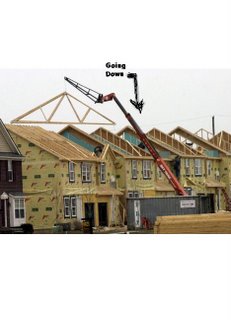....Must Come Down

You know the first part of the title already don't you?
What goes up....
And now even the national news media has noticed a whole lotta something coming down.
We're taking bets on how long it will take before the FB's get their glass stomach's cleaned up enough to read the writing on the wall. When the national news media is considered progressive compared to the awareness of the average joe... it makes for good fun to calculate just how much of a leading indicator they are... I say a year before they pull their heads out far enough to panic.... what are your predictions?
"Sales of new homes fell in June for the first time in four months, and the government also lowered figures for May, providing further evidence the high-flying housing market is losing altitude."
"The government marked down sales activity in May to a pace of 1.166 million units, substantially below its initial estimate of 1.234 million units. Analysts pointed to the drop in sales last month and the downward revision for May as fresh evidence that housing was slowing considerably from the impact of higher mortgage rates."
"The big worry is that home sales will fall so sharply that it could send shock waves through the economy, much as the bursting of the stock market bubble in 2000 contributed to the recession the next year."
"In June, sales were weak in every section of the country except the West, which posted an 8.2 percent increase after a decline of 7.3 percent in May. Sales fell 11.3 percent in the Northeast and were down 7.9 percent in the Midwest and 6 percent in the South."
"The Commerce Department reported Thursday that new home sales dropped by 3 percent last month to a seasonally adjusted annual sales pace of 1.131 million units. It was the first decline since an 11.5 percent drop in February."
"Analysts said the drop in new home sales was consistent with the slowdown shown this week in sales of existing homes, which fell for the eighth time in the past 10 months."
'"The housing market peaked a year ago and has been slowly deflating ever since," said Mark Zandi, chief economist at Moody's Economy.com. "We can expect another year of lower sales with price declines in some parts of the country."'








